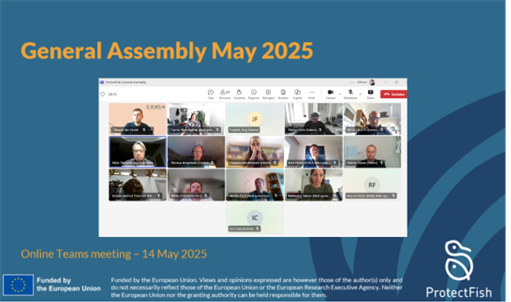On 14 May 2025, members of the ProtectFish project gathered online for the 2025 General Assembly. The meeting brought together all project partners as well as several members of the External Advisory Board (EAB).
Project partners shared updates from their respective work packages, exchanging insights – particularly from the numerous field experiments conducted by project partners across Europe. This while also identifying new opportunities to strengthen joint efforts and drive the project forward.
Among the highlighted activities, project partner DTU Aqua reported on its field-work in Denmark. Here four stetches in the rivers – Storeå, Arnå, Gudenå, and Grindsted å – were selected as pilot sites. In collaboration with local sportfishing associations, reported earlier here, they have implemented a protocol to assess the protected species’ interactions with visiting cormorants and the effectiveness of biodiversity management options in river systems.
Similar efforts are ongoing in the Austrian Drau-river and the Polish San-river, where there were problems in achieving the necessary permissions to implement measures to keep cormorant presence at a minimum. This was an obstacle expected, but missing permissions can really disrupt such large-scale field experiments, so a good dialogue with the relevant authorities is crucial for the success of the field studies to be able to provide much needed documentation of the effect of predator management on wild fish populations. In our next reporting, we will bring more details from the Polish and Austrian field-sites.
A central component of the project’s research involves the monitoring of river stretches across Europe using wildlife cameras. These devices have collectively captured millions of images, providing valuable data on fish behaviour and their predators’ activities. To streamline the analysis of this vast dataset, ProtectFish has established a dedicated “Camera Task Force.” This group is currently developing an AI-supported online tool designed to automatically classify the images by identifying the presence or absence of key predators, such as cormorants. The tool will significantly reduce the manual effort required from project partners to sort the images caught. It will also accelerate the pace and accuracy of data analysis.
DTU Aqua has also developed for ProtectFish an online reporting application. This aimed at recruiting volunteers to get engaged in the field experiments. The app allows users to log their sightings and activity while patrolling selected river sites. This real-time data collection is vital for researchers seeking to quantify the level of cormorant activity and evaluate its impact on fish populations in smaller, inland streams.
The project team now looks ahead to continuing its work to support sustainable and science-based fisheries management in Europe.

